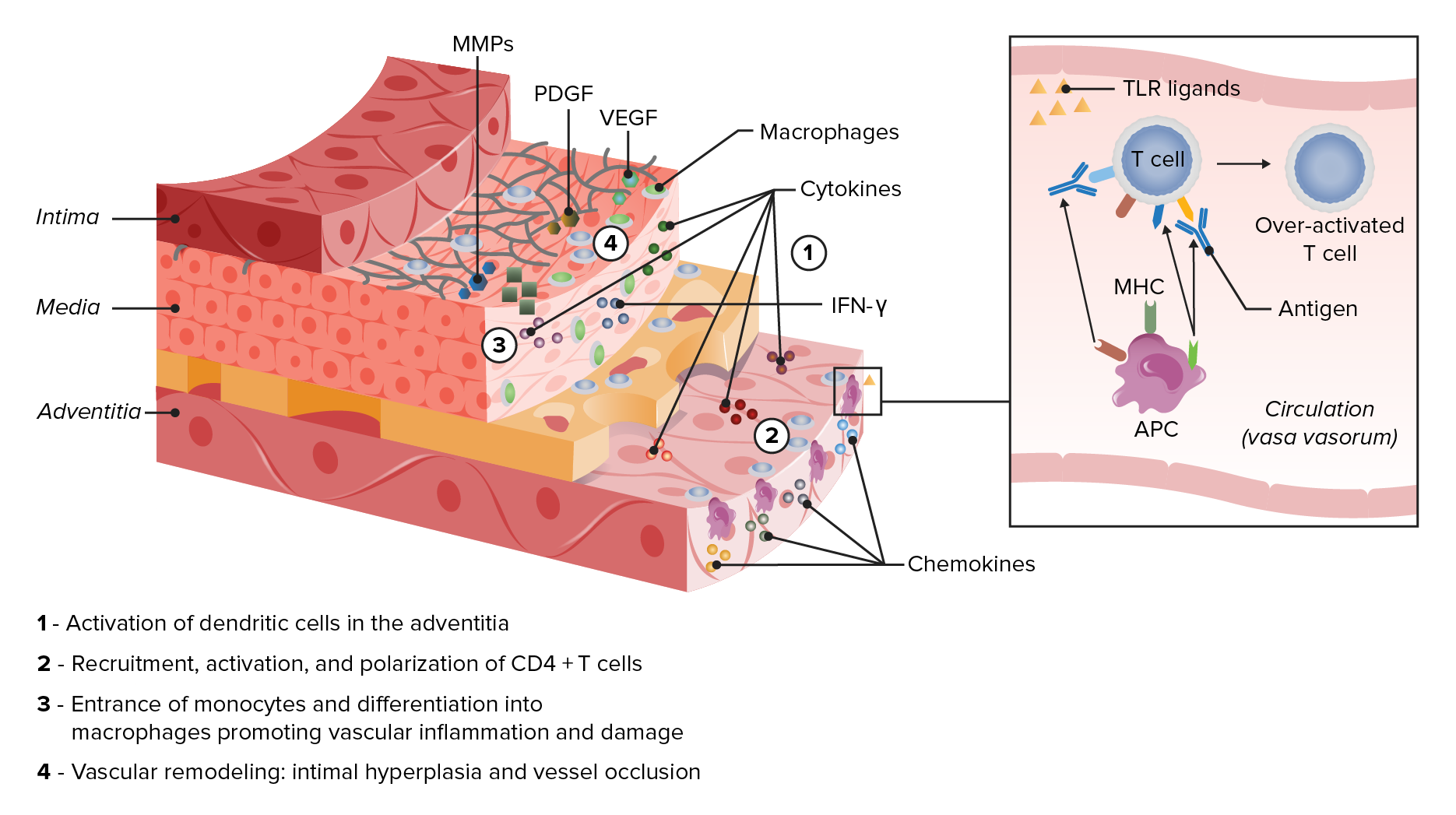Playlist
Show Playlist
Hide Playlist
Giant Cell Arteritis
-
Slides Vasculitis Mitchell.pdf
-
Reference List Pathology.pdf
-
Download Lecture Overview
00:01 Okay, so that's granulomatous disease, giant cell arteritis and Takayasu's arteritis all the way on the left hand side at the bottom. 00:12 Okay, let's move along to some other ones. 00:15 So, let's talk about giant cell arteritis or temporal arteritis. 00:20 Smaller vessels with the same granulomatous inflammation. 00:26 So this is going to be chronic inflammatory disease of large medium-sized vessels, like the temporal artery, vertebral artery, ophthalmic artery. 00:35 The name is called temporal arteritis, but most of the vessels of the head and neck in patients who have this disease are involved. 00:41 But we make our diagnosis of temporal artery biopsies and hence the name temporal arteritis. 00:49 It is among the more common of idiopathic systemic vasculitis and the one that if you are going to encounter vasculitis in your clinical practice, this is the one more likely that you will encounter. 01:02 It's more common in individuals who are older, it's distinctly uncommon if you're younger than 50 years old. 01:08 And as you age 60, 70, 80, it is a more common arteritis that will occur. 01:15 It is three times more common in females than men, but clearly men can get this disease. 01:20 So, what causes it? We don't know. 01:23 The exact cause is unknown. 01:25 However, what we do know is that there are certain genetic factors that can increase susceptibility and this includes facts that certain MHC variants, and certain HLA subtypes are specifically associated with giant cell arteritis. 01:43 Many genes that are involved in T cell activation polymorphisms in those genes can also drive or be associated with the disease. 01:50 But again, we don't really know the exact etiology. 01:54 Half the patients roughly will have concurrent polymyalgia rheumatica, meaning they have diffuse muscle and joint aches and pains. 02:03 Kind of not otherwise well-described. 02:07 But polymyalgia rheumatica is certainly part of the giant cell arteritis family or part of the presentation. 02:14 Again, probably due to systemic cytokine elaboration. 02:18 General signs and symptoms. 02:20 Again, nonspecific and cytokine related fatigue, malaise, you can also have weight loss due to the elaboration of tumour necrosis factor. 02:28 So, because of the involvement of most of the arteries of the head and neck in a giant cell arteritis, you can get various manifestations related to specific arteries that are involved. 02:40 Here, just showing you the facial artery, one of the fit point of the arteries there with jaw claudication. 02:46 So it hurts after you chew a lot or after you talk a lot. 02:51 You can have temporal artery involvement. 02:54 It's the same disease, but here you getting headaches localized to the temples. 02:58 You can have associated scalp tenderness. 03:00 You can have involvement of the ophthalmic artery. 03:03 And this is actually the one that is most feared that complication. 03:07 Patients can get transient loss of vision due to diminished flow, it feels like there's a curtain being pulled over their eyes. 03:15 But you can get permanent vision loss due to infarct, basically, the optic, the retina dies as a result of that, you can get complete vision loss and it can happen very quickly. 03:30 It can happen in a matter of hours. 03:33 So what does this look like? So this is a smaller vessel vasculitis. 03:36 This is not vessels of the arch that's not the aorta, but this is temporal artery size so this is kind of artery to arterial. 03:45 And what we see very classically is inflammation that involves all three layers, intima, media, and adventitia with destruction of the media layer, and classically, we see giant cells and granulomatous inflammation. 04:02 In the giant cells are just shown there highlighted on the left hand side. 04:07 Giant cells are nothing more than infusion of activated macrophages. 04:11 That's all what they are. 04:12 Okay, so that's just an example now of a granulomatous inflammation involving medium-sized vessels.
About the Lecture
The lecture Giant Cell Arteritis by Richard Mitchell, MD, PhD is from the course Vasculitis.
Included Quiz Questions
What is the most common idiopathic systemic vasculitis?
- Giant cell arteritis
- Takayasu arteritis
- Kawasaki disease
- Anti-glomerular basement membrane disease (Goodpasture syndrome)
- Microscopic polyangiitis
Giant cell arteritis causes jaw claudication. Which artery is affected, causing this symptom?
- Facial artery
- Temporal artery
- Ophthalmic artery
- Subclavian artery
- Common carotid artery
Customer reviews
5,0 of 5 stars
| 5 Stars |
|
5 |
| 4 Stars |
|
0 |
| 3 Stars |
|
0 |
| 2 Stars |
|
0 |
| 1 Star |
|
0 |





